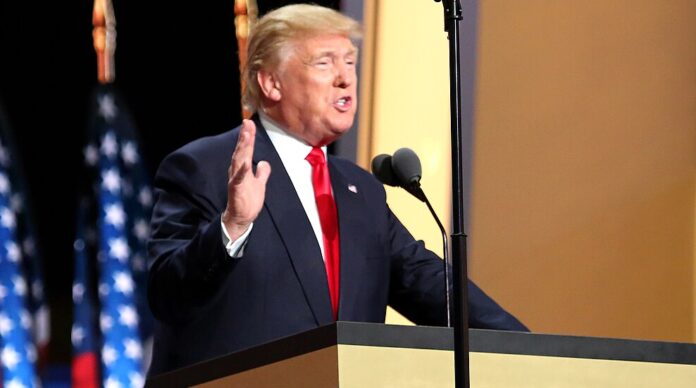Former President faces backlash over alleged altercation and breach of cemetery protocol
Former President Donald Trump’s visit to Arlington National Cemetery on August 26, 2024, quickly turned controversial, generating significant backlash and scrutiny. Trump’s visit aimed to honour the 13 U.S. service members who lost their lives in the Abbey Gate bombing at Kabul’s Hamid Karzai International Airport on August 26, 2021.
During the visit, which coincided with the third anniversary of the bombing, Trump laid a wreath at the Tomb of the Unknown Soldier. However, the event took a contentious turn when reports emerged of a physical and verbal altercation involving Trump’s team and a cemetery official.
Embed from Getty ImagesAccording to Trump’s campaign officials, a cemetery staff member physically blocked their access, causing a confrontation. The cemetery confirmed the incident and noted that a report was filed, but did not offer further details. In response, Trump’s campaign posted a video on TikTok showcasing the visit and the wreath-laying ceremony, arguing that the presence of their official videographer and photographer had been approved by the families of the fallen soldiers.
Federal regulations strictly prohibit political campaign activities, including filming and photography, within Army National Military Cemeteries to preserve their solemnity. Arlington National Cemetery officials reiterated that this prohibition was communicated to all participants, including Trump’s team.
NPR reported that the altercation involved Trump’s staff verbally abusing and physically pushing aside the cemetery official who attempted to enforce these rules. Trump’s spokesperson, Steven Cheung, refuted the claims of physical confrontation but acknowledged that an individual obstructed their team’s access. Campaign manager Chris LaCivita condemned the obstruction as disgraceful and accused the cemetery staff of dishonouring the service members.
Trump’s running mate, Sen. JD Vance, minimized the incident, calling it a “little disagreement” and asserting that evidence supports the campaign’s claim of authorization to photograph the event. On the other hand, Virginia Democratic Rep. Gerry Connolly demanded transparency, urging the Arlington Cemetery leadership to release the full report on the incident to ensure the cemetery’s integrity is maintained.
The incident highlights ongoing debates about the intersection of political activities and national memorials, illustrating the complexities and sensitivities involved in commemorating fallen heroes while navigating political contexts.
Analysis:
Political: The controversy surrounding Trump’s visit to Arlington National Cemetery reflects broader tensions in American politics. The incident underscores how political figures often navigate sensitive issues, such as national memorials, to garner support and visibility. Trump’s campaign’s attempt to use the visit for political gain, despite regulations prohibiting such activities, amplifies debates about the appropriateness of political activities in solemn contexts. The backlash from Democrats and the defense from Trump’s campaign reveal the polarized nature of American politics, where actions are often scrutinized through partisan lenses.
Social: Socially, the incident mirrors ongoing debates about the role of public figures in memorial settings. The clash over Trump’s use of the visit for political purposes raises questions about respect and propriety in commemorative spaces. The public’s reaction—ranging from support for Trump’s right to honour fallen soldiers to criticism of his campaign’s perceived exploitation of the event—reflects broader societal norms about how public figures should conduct themselves in sensitive settings. This controversy highlights the tension between personal and political motives in public ceremonies and the public’s expectations of decorum and respect.
Racial: The racial implications of this incident are less direct but still relevant. The controversy illustrates how political and public figures navigate diverse constituencies and their expectations. While the specific racial impact of this event might not be prominent, the broader context of how public figures engage with communities of colour and their expectations of respect and solemnity in public spaces can be a consideration. The event’s focus on honouring military service members intersects with broader discussions about how various communities perceive and respond to political actions.
Gender: The gender dynamics in this event are subtle but significant. The role of female officials and family members, like Misty Fuoco, who attended the ceremony, reflects the broader involvement of women in military and public remembrance activities. The incident does not directly address gender issues, but the participation and roles of women in such ceremonies highlight their growing presence and influence in traditionally male-dominated spaces.
Economic: Economically, the controversy underscores the costs associated with high-profile political events. The dispute over the use of photographic and videographic resources reflects broader issues about the economic implications of staging political events. The use of campaign funds for such activities and the potential economic impact of negative publicity can influence political strategies and decisions. Additionally, the financial implications for the Arlington National Cemetery, including the potential costs associated with managing and addressing such incidents, are part of the broader economic context.
